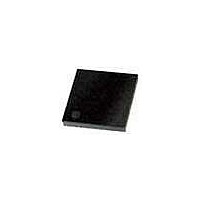PIC18F44K20-E/MV Microchip Technology, PIC18F44K20-E/MV Datasheet - Page 105

PIC18F44K20-E/MV
Manufacturer Part Number
PIC18F44K20-E/MV
Description
16KB, Flash, 768bytes-RAM, 36I/O, 8-bit Family,nanowatt XLP 40 UQFN 5x5x0.5mm TU
Manufacturer
Microchip Technology
Series
PIC® XLP™ 18Fr
Datasheet
1.PIC18F25K20T-ISS.pdf
(456 pages)
Specifications of PIC18F44K20-E/MV
Processor Series
PIC18
Core
PIC18F
Data Bus Width
8 bit
Program Memory Type
Flash
Program Memory Size
8 KB
Data Ram Size
512 B
Interface Type
I2C, SPI, SCI, USB, MSSP, RJ11
Maximum Clock Frequency
64 MHz
Number Of Programmable I/os
35
Number Of Timers
4
Operating Supply Voltage
1.8 V to 3.6 V
Maximum Operating Temperature
+ 125 C
Mounting Style
SMD/SMT
Package / Case
UQFN-40
Development Tools By Supplier
MPLAB Integrated Development Environment
Minimum Operating Temperature
- 40 C
Operating Temperature Range
- 40 C to + 125 C
Supply Current (max)
30 uA
Core Processor
PIC
Core Size
8-Bit
Speed
48MHz
Connectivity
I²C, SPI, UART/USART
Peripherals
Brown-out Detect/Reset, HLVD, POR, PWM, WDT
Number Of I /o
35
Eeprom Size
256 x 8
Ram Size
768 x 8
Voltage - Supply (vcc/vdd)
1.8 V ~ 3.6 V
Data Converters
A/D 14x10b
Oscillator Type
Internal
Operating Temperature
-40°C ~ 125°C
Lead Free Status / Rohs Status
Details
- Current page: 105 of 456
- Download datasheet (4Mb)
8.0
8.1
All PIC18 devices include an 8 x 8 hardware multiplier
as part of the ALU. The multiplier performs an unsigned
operation and yields a 16-bit result that is stored in the
product register pair, PRODH:PRODL. The multiplier’s
operation does not affect any flags in the STATUS
register.
Making multiplication a hardware operation allows it to
be completed in a single instruction cycle. This has the
advantages of higher computational throughput and
reduced code size for multiplication algorithms and
allows the PIC18 devices to be used in many applica-
tions previously reserved for digital signal processors.
A comparison of various hardware and software
multiply operations, along with the savings in memory
and execution time, is shown in Table 8-1.
8.2
Example 8-1 shows the instruction sequence for an 8 x 8
unsigned multiplication. Only one instruction is required
when one of the arguments is already loaded in the
WREG register.
Example 8-2 shows the sequence to do an 8 x 8 signed
multiplication. To account for the sign bits of the argu-
ments, each argument’s Most Significant bit (MSb) is
tested and the appropriate subtractions are done.
TABLE 8-1:
2010 Microchip Technology Inc.
16 x 16 unsigned
8 x 8 unsigned
16 x 16 signed
8 x 8 signed
Routine
8 x 8 HARDWARE MULTIPLIER
Introduction
Operation
PERFORMANCE COMPARISON FOR VARIOUS MULTIPLY OPERATIONS
Without hardware multiply
Without hardware multiply
Without hardware multiply
Without hardware multiply
Hardware multiply
Hardware multiply
Hardware multiply
Hardware multiply
Multiply Method
Program
Memory
(Words)
13
33
21
28
52
35
1
6
EXAMPLE 8-1:
EXAMPLE 8-2:
PIC18F2XK20/4XK20
MOVF
MULWF
MOVF
MULWF
BTFSC
SUBWF
MOVF
BTFSC
SUBWF
Cycles
(Max)
242
254
69
91
28
40
1
6
ARG1, W
ARG2
ARG1, W
ARG2
ARG2, SB
PRODH, F
ARG2, W
ARG1, SB
PRODH, F
@ 40 MHz
24.2 s
25.4 s
100 ns
600 ns
6.9 s
9.1 s
2.8 s
4.0 s
8 x 8 UNSIGNED
MULTIPLY ROUTINE
8 x 8 SIGNED MULTIPLY
ROUTINE
;
; ARG1 * ARG2 ->
; PRODH:PRODL
; ARG1 * ARG2 ->
; PRODH:PRODL
; Test Sign Bit
; PRODH = PRODH
;
; Test Sign Bit
; PRODH = PRODH
;
@ 10 MHz
102.6 s
27.6 s
36.4 s
96.8 s
16.0 s
11.2 s
Time
400 ns
2.4 s
DS41303G-page 105
- ARG1
- ARG2
@ 4 MHz
242 s
254 s
69 s
91 s
28 s
40 s
1 s
6 s
Related parts for PIC18F44K20-E/MV
Image
Part Number
Description
Manufacturer
Datasheet
Request
R

Part Number:
Description:
Manufacturer:
Microchip Technology Inc.
Datasheet:

Part Number:
Description:
Manufacturer:
Microchip Technology Inc.
Datasheet:

Part Number:
Description:
Manufacturer:
Microchip Technology Inc.
Datasheet:

Part Number:
Description:
Manufacturer:
Microchip Technology Inc.
Datasheet:

Part Number:
Description:
Manufacturer:
Microchip Technology Inc.
Datasheet:

Part Number:
Description:
Manufacturer:
Microchip Technology Inc.
Datasheet:

Part Number:
Description:
Manufacturer:
Microchip Technology Inc.
Datasheet:

Part Number:
Description:
Manufacturer:
Microchip Technology Inc.
Datasheet:










